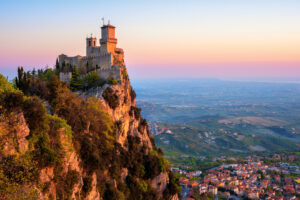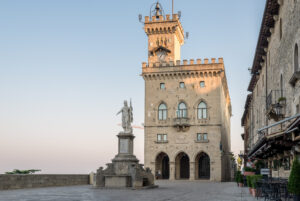On 7 July 2008, San Marino and Borgo Maggiore Historic Centers and Mount Titano were inscribed on the World Heritage List.
UNESCO described San Marino as “one of the world’s oldest republics and the only surviving Italian city-state, representing an important stage in the development of democratic models worldwide. The tangible expressions of this long continuity as the capital of its Republic, its unchanged geo-political context and juridical and institutional functions, is found in the strategic position of the top of Mount Titano, the historic urban layout, urban spaces and many public monuments. The defensive walls and the historic center have undergone changes over time that include intensive restoration and reconstruction between the end of 19th century and the first decades of the 20th century, a process which can be considered to be part of the history of the property and reflects changing approaches to conservation and presentation of heritage over time.
San Marino is a mountainous microstate surrounded by north-central Italy. Among the world’s oldest republics, it retains much of its historic architecture. On the slopes of Monte Titano sits the capital, also called San Marino, known for its medieval walled old town and narrow cobblestone streets. The Three Towers, castlelike citadels dating to the 11th century, sit atop Titano’s neighboring peaks.
Historical Background
The territory of the Republic of San Marino was frequented and inhabited since remote times, as testified to by the discovery of several archaeological remains dating back from the Eneolithic Age (third millennium B.C.) onwards. Important traces of human presence have been found for the Bronze and Iron Ages, as well as for the Villanovan, Roman and Goths’ Ages.

On Mount Titano, where the San Marino community first settled, the remains of an important cultural site have also been found. In this place, which started to be frequented in the 5th century B.C., a divinity was worshipped, which was thought to have thaumaturgic powers.
The community, from which the State of San Marino subsequently originated, consolidated during the late Middle Ages, probably around a monastery, which had been built on Mount Titano already in the 6th century B.C. The legendary origin of the San Marino society is instead with the arrival on Mount Titano of a Saint Man, Marino, coming from the island of Rab, Dalmatia. In 257 A.D., Marino arrived in Rimini to work as a stonecutter and subsequently he decided to move to Mount Titano to live as a hermit. Marino lived here, surrounded by people attracted by his charisma, until his death in 301 A.D. He received Mount Titano as a gift from the legitimate owner, in favour of whom he had performed a miracle and subsequently he bequeathed it to those who had lived around him.
In fact, the territory, on which the San Marino society subsequently consolidated, was under the political control of the Pope and of the Bishop of Montefeltro. Only staring from the late 13th century, during the Age of the Commune, San Marino citizens started to slowly free themselves from this dominion, by developing their own statutes, judiciary and political bodies able to autonomously manage the community.

In this regard, San Marino citizens could count on the help of the Montefeltros, Lords of Urbino, who were at war with the Malatestas, Lords of Rimini, and with the Pope. Indeed, the Montefeltros considered San Marino as a powerful outpost and an important ally, therefore they favoured its territorial development, military strengthening and desire for autonomy.
In 1300s, San Marino continued to slowly free itself from the Bishop’s political powers and to increase its territory, which reached today’s dimensions (61 square kilometres) in 1463. Indeed, in this year, San Marino received some villages and Castles as a reward for having contributed to the defeat of the army of Sigismondo Malatesta, who, at that time, was at war with the Pope.
During the early 1600s, the Duchy of Urbino became part of the Papal State. However, San Marino, thanks to its diplomatic ability, managed to remain independent, although it had to accept the “protection” of Rome, which actually consisted in a steady control over its freedom of action and autonomy. Indeed, the Papal State considered the freedom of San Marino as something partial resulting from its exclusive concessions. In 1739, in the light of this, the Papal State tried to put an end to this situation by occupying the small State through Cardinal Giulio Alberoni. However, after some months, the Pope understood that the majority of San Marino citizens did not admit the fact of losing their own freedom and that this occupation had created some discontent in various European Courts. Therefore, on 5 February 1740, it decided to give back to San Marino its ancient independence, although it remained subject to “protection” and supervision as in the past.
Geography
Location: Southern Europe, an enclave in central Italy
Geographic coordinates: 43 46 N, 12 25 E
Area: Total: 61 sq km
Land boundaries: Total: 39 km
Border countries: Italy 39 km
Terrain: Rugged mountains
Elevation extremes: Lowest point: Torrente Ausa 55 m
Highest point: Monte Titano 755 m
Climate: Mediterranean; mild to cool winters; warm, sunny summers

